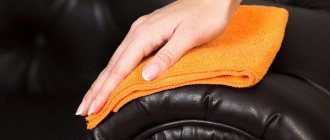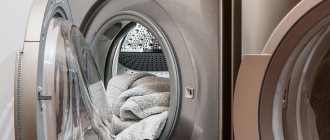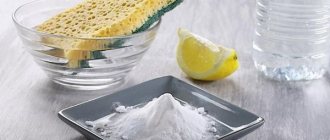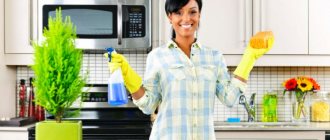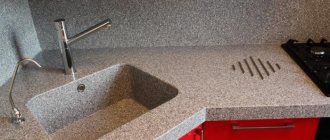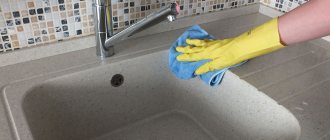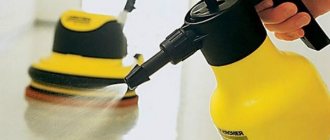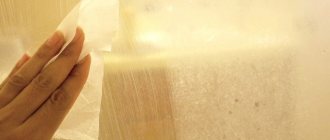Features of removing contaminants from different types of surfaces
Matte surfaces
To remove difficult stains, you can use low-abrasive cleaning powders. To remove small stains, a soap solution or ammonia-based product is suitable. Then the tabletop is wiped with a wet cloth, after which it is polished to a shine in a circular motion using a sponge.
Semi-gloss surfaces
A bleach solution and a non-abrasive paste based on it work well against difficult stains. Soapy water is suitable for removing small stains. Then the tabletop needs to be wiped dry. A non-abrasive polishing paste will help add shine and improve its color. And finally, polish with a paper towel to remove streaks.
Glossy surfaces
They are difficult to care for, so the use of abrasive products, including hard sponges, is not allowed. To remove difficult stains, use a white polishing mixture, which is applied with a soft cloth using light circular movements. Common stains can be removed with soap and water.
We select effective and safe products for cleaning artificial stone sinks
Where does heavy contamination come from in such car washes? They are not happy with temperature changes, berries and coffee can also leave visible contamination, rust appears from a loosely closed tap, and a white limescale deposit on an artificial stone sink looks unpleasant.
Therefore, you definitely need to figure out what you can use to clean a sink made of artificial stone.
How to clean a porcelain stoneware sink using folk remedies
First, let’s find out what folk natural remedies are effective. Anything that can get your sink dirty. Let's try to remove dirt with improvised compounds.
Soda helps remove various kinds of stains and grease: you just use a paste of water and soda, but without using your heroic power.
Favorite kitchen toolPHOTO: bu-bu-bu.ru
Those who have used mustard powder have appreciated how easily greasy stains and deposits disappear under its pressure.
You also need to dilute the powder with water until it becomes a paste. PHOTO: legkovmeste.ru
The resulting mixture should be applied to the area of contamination and left for half an hour.
Without lemon there is nothing to do in the kitchen.
This is an excellent product for removing white plaque on the sink PHOTO: vplate.ru
You don’t even have to rush to remove the juice, leaving it for 25 minutes. Instead of lemon, use diluted citric acid. The sink is closed with a stopper and filled with warm water, in which 50 g of citric acid is dissolved. Now you can go to bed and in the morning all that remains is to flush the water.
You can take table vinegar for washing: it will help remove lime deposits and some stains.
Vinegar (9%) must first be diluted with water in proportions of 1 to 2 PHOTO: kliningovyj-raj.ru
If you have vinegar essence at home, then take the proportions 1 to 10.
Dip a sponge into the mixture, wring it out lightly and wipe the surface. You can lightly rub heavy dirt with the back of the sponge.
Sprite, 7up, and Cola can also be used to clean a sink made of artificial stone. The drain is closed with a stopper and sweet carbonated water is generously poured into the sink. The “soaking” process lasts from half an hour to an hour, but from time to time you need to come up and wet the walls of the sink with a sponge and soda.
Sprite cleans light surfaces well PHOTO: utkonos.ru
You can wash the sink well with toothpowder or paste, wiping it with a sponge with this product. The powder should be in a pulp state.
Cleaning artificial stone sinks with professional products
Not every tool can be used. The first thing that deserves attention is a melamine sponge, which can remove rust and salt stains.
Chlorine-containing compounds remove traces of various dyes: beets, coffee, tea, fat recede.
This is Whiteness, Domestos, KometPHOTO: utkonos.ru
The composition of the product should be marked that it is suitable for composite materials. You can consider options for gels with a mild effect: Mister Muscle, CIF, Mister Chister, Ecover
You can treat the surface with a dishwasher tablet. To do this, dissolve it in a tablespoon of water.
How to clean an acrylic bathtub?
Acrylic is one of the most common materials on the modern plumbing market. If once upon a time most bathtubs and sinks were made of metal and cast iron, now acrylic is used for their production. It has a number of advantages, which include:
- resistance to negative factors (corrosion, mold, fungus);
- light weight of the structures, which makes it possible to install them yourself;
- good heat-saving characteristics (only 1 degree is lost in half an hour);
- wide range of sizes and shapes.
Acrylic bathtubs
The only drawback of acrylic bathtubs is their low strength compared to other materials for the manufacture of sanitary structures. But with proper care and timely repairs, such bathtubs can last for many years.
Acrylic bathtubs need to be washed properly
Types of acrylic bathtubs
Today, a special type of material is used to make acrylic bathtubs, which is practical for use in places with high humidity. There are two types of acrylic structures: extruded and cast, which differ in manufacturing features.
An example of making an acrylic bathtub
Extrusion is the process of pressing an acrylic mixture with fillers, and a bathtub made in this way is installed on a reliable frame. Cast structures have higher strength, so it can be mounted directly on the legs that come included. The difference in the characteristics of the material also affects the care and cleaning features of the bathtubs - extruded ones must be handled more carefully, since the thickness of the acrylic layer is much smaller.
Operation of acrylic bathtubs
Operate the bathtub correctly and carefully
To avoid damage and severe contamination of the surface of acrylic bathtubs, the following operating conditions must be observed:
- do not wash clothes with buttons, zippers or other metal accessories that can scratch the surface;
- do not pour household waste into the bathtub;
- do not wash pets, as they can scratch the bowl with their claws;
- refrain from smoking near the acrylic bathtub;
- Do not store basins, bowls or other objects that could damage the surface in the bathtub.
Do not bathe animals in an acrylic bathtub
Caring for acrylic bathtubs
The basic rule for caring for acrylic bathtubs is: you need to wash and clean its surface as often as possible, since dealing with minor stains is much easier than cleaning stubborn stains. After each use, the bathroom should be rinsed with water and some mild product (for example, liquid soap) and wiped dry - leaving it wet for a long time is not recommended.
Wipe the bath with a dry cloth
In addition, you need to constantly monitor the serviceability of the plumbing, since water dripping all the time will lead to the appearance of a yellow coating. Once every 2-3 weeks you need to do a general cleaning and clean the bathroom completely.
Removing simple stains
Simple stains that have not yet become deeply embedded in the surface can be easily washed off with liquid soap and a sponge.
Remove simple stains with a soft sponge and soapy foam.
If the mud has dried out a little, you need to fill the bath with warm or hot (never boiling water) water and wait a little until it soaks. Contaminated areas on the sides can be softened by placing a wet cloth on it. For general cleaning, you need to use household chemicals, but the choice is quite limited, and the use of non-household products like gasoline and acetone is generally prohibited.
Products prohibited for cleaning acrylic include abrasives, chlorine and other chemicals.
| Means or substance | Impact on acrylic |
| Powders and other chemicals that contain abrasives (Komet, Biolan, etc.) | Abrasives can scratch the surface of the structure, causing it to appear dull and gray. |
Products containing chlorine | Chlorine or household chemicals that contain this substance will cause the acrylic to become cloudy, and upon repeated use the surface will become porous |
| Acetone and similar solvents | Such chemical compounds will also make the surface cloudy, and with regular use they will corrode the material. |
Ammonia | Ammonia affects acrylic in the same way as acetone-containing products, but to a slightly lesser extent |
The best option for cleaning acrylic structures is special household chemicals designed for plastic (“Sif”, “Bass”, “Akrilan”).
Cream "Sif"
Akrilan
acrylan bugs
- Gels and pastes. Liquid products cope well with limescale, yellowness and other stubborn dirt. They are applied to the dirt, distributed evenly over the surface, after which you need to rub it with a sponge and rinse with warm water.
- Sprays. Products for acrylic surfaces in the form of sprays (aerosols) are quite easy to use and remove fresh dirt well.
Not only do they have a mild effect (they can even clean silicone sealant used to cover seams), but they also form a protective film on the plastic. Apply the spray to the surface, wait a few minutes, then rinse with water. The only drawback of such funds is the fairly high cost. Spray for acrylic bathtubs - Powders. If there is no other product other than powder at hand, you can clean the bathtub with this product, but do not rub the surface, but first dissolve the product in water.
In addition, when cleaning acrylic surfaces, do not use hard sponges, metal graters or other objects that can scratch the bathtub.
Acrylic bath sponge
Removing complex stains
Complex contaminants are rust stains that appear on the surface of plumbing mainly due to constantly flowing drops of water, lime deposits and water stone from hard water, as well as all deeply ingrained dirt. They are removed using special household cleaners, which include the following brands.
| Name | Active components | Features of use |
| "Mr. Cheester" | Acrylic copolymer | A product for the care of any plumbing structures (baths, shower trays, sinks). Removes dirt, yellowness, and limescale well without damaging the surface |
"Sun Klin" | Water soluble acrylic polymer | Has a neutral pH level, does not contain alkali, acid or abrasives, effectively cleans the surface and additionally forms a protective film |
| "Ravak" | Soft components designed specifically for cleaning acrylic | A line of detergents to combat various types of pollution: limescale (Ravak Cleaner), greasy deposits (Ravak Turbo Cleaner), etc. |
| "Bagi Akrilan" | Organic acids and solvents | The product effectively removes all types of stains, including rust, mildew and mold, adds shine to plumbing fixtures, and protects against the formation of limescale. |
| "Team Pro" | Organic solvents, sodium salts | Does not contain abrasive particles, removes stubborn and stubborn dirt well, does not damage surfaces, disinfects and gives them a mirror shine |
They effectively remove complex contaminants, but in any case they have an aggressive effect on the material, so it is recommended to use them as rarely as possible.
It should be noted that when cleaning bathrooms, you need not only to choose the right detergents and cleaning products, but also to follow some safety rules. Firstly, household chemicals in powder form should be applied only to a damp surface - particles from a dry bath can rise into the air and enter the respiratory tract. Secondly, even to achieve ideal cleanliness, you should not mix different products, as they can enter into a chemical reaction, resulting in the formation of toxic fumes.
How to clean a bathtub from limescale
This is what limescale looks like
Limescale deposits from acrylic surfaces can be easily removed using acids that are used in everyday life, that is, lemon juice or vinegar. To do this, you need to fill it with warm water (temperature no more than 30 degrees), add the juice of one lemon or 50 ml of ordinary vinegar.
Vinegar and lemon as a means to remove limescale
Wait 12 hours, periodically adding warm water so that the temperature in the bath remains stable. Remove the plug, rinse off the remaining acid well with cold water and wipe the surface dry.
Rust
Rust stain on bathtub
Removing rust from acrylic is quite difficult, since it eats deeply into the surface of the material. To cope with such a nuisance, the housewife will need soda ash (baking soda and baking soda), vinegar and regular household chlorine-free bleach. Mix both types of soda in equal proportions (2 tablespoons each) and apply to a damp surface, but do not rub. Dilute bleach with vinegar (50 g each) and after 10 minutes apply the solution over the soda. Leave the bath for half an hour, then rinse well with water.
Removing rust from an acrylic bathtub
This is an effective way to remove rust, but it can be classified as radical, so you can use such means only in isolated cases.
Yellow spots
Spots of an unpleasant yellow or grayish color can appear on the surface of acrylic not only from constantly flowing drops of water, but also simply from time to time. Small individual stains can be removed with toothpaste that does not contain abrasive particles - it is applied to the contaminated area, left to act for several minutes, and then rinsed off well.
You can clean your bathtub with toothpaste.
You can also bleach the surface with a mixture of ammonia and hydrogen peroxide (proportion 1 to 1). You can simply apply it to the stains, lightly rub in with a soft sponge and rinse well. If you need to clean a large surface, you need to soak scraps of cloth or napkins in the solution, line the bath with them, leave for half an hour and remove the residue well.
A mixture of ammonia and hydrogen peroxide
Cleaning methods at home
To remove stains from a varnished surface, household chemicals and folk remedies are used. The latter often allow you to achieve a more pronounced effect.
Beer
To remove traces of dirt, you will need to mix malt beer and wax. This composition must be boiled to remove the alcohol.
Special solution
A mixture of shampoo, water and antistatic agent, taken in equal proportions, helps to remove stubborn dirt and grease from polished furniture with your own hands. The latter prevents dust from settling on the surface.
Olive oil and wine vinegar
To clean furniture, you need to mix both components in equal proportions and wash the varnished surface. Wine vinegar can cope with various types of stains. At the same time, the liquid disinfects the surface being treated. Olive oil is used to restore shine.
Burr oil
To remove dirty stains, just apply this oil to problem areas and after 5-7 minutes wipe the surface with a dry material.
Turpentine, vinegar and flax oil
You can clean contaminated furniture with a mixture of 50 milliliters of linseed oil and turpentine with the addition of 25 milliliters of vinegar essence. In this composition you need to dip a piece of cotton wool and quickly wipe the problem areas.
Sauerkraut brine
To get rid of traces of dirt, just soak a piece of cloth in an acidic solution of sauerkraut and rinse the problem areas, and then clean the surface with a dry cloth. After this procedure, you should also treat the furniture with flannel.
Effective polishes
The use of polishes eliminates the need to prepare cleaning compounds. In addition, cleaning furniture with household chemicals reduces the likelihood of scratches or other defects resulting from poor proportions.
Pronto
This polish is one of the most popular. Simply apply the product to the problem surface and wipe with a dry cloth.
Chirton
Also refers to popular polishes. Chiron contains wax, thanks to which, after treatment, the surface restores its former shine.
Emsal
Emsal has a soft effect on the processed material and hides minor scratches. The polish does not contain wax or silicone.
How to clean marble
To fill the pores on the surface of marble and give a decorative appearance, the product is coated with a thin layer (from 1 to 5 mm) of epoxy resin - gelcoat. The material prevents mechanical and chemical damage to the finished product, does not allow odors and dirt particles that cause mold to be absorbed. At the same time, the thin coating is susceptible to damage from impacts from hard and sharp objects.
Gelcoat is a coating resistant to chemical and mechanical stress, but some cleaning methods are not applicable to it.
- Metal and hard plastic brushes scratch the surface - it loses its shine and gloss.
- Do not wash marble with cleaning products containing abrasive particles - this will make the surface matte. Restoring the appearance will require polishing using special compounds and tools.
- Cleaning the surface with aggressive detergents (acids or alkalis), which can dissolve the coating, is also contraindicated.
We proceed directly to removing stains from the stone. As stated earlier, cleaning procedures depend on the type of contamination. So, if there are traces of organic origin on the marble - food, tobacco, drinks, waste products of domestic animals, then such a well-known household attribute as hydrogen peroxide can best deal with them. In order to clean a porous stone, you will need to prepare a kind of compress.
- It is necessary to moisten some absorbent fabric with peroxide: a paper napkin, a blotter or simply a rag.
- Apply the resulting mixture to the stain.
- Place a wet napkin or rag on top.
- Cover everything with film.
All this is left for 24 hours, after which the procedure can be carried out again if the stains are not completely removed.
How to clean marble from greasy stains, be it resin, oil, cosmetics or hand cream? Such substances leave dark marks on the stone. The only detergent here is absorbent powder (crushed chalk or starch) and ammonia. Cleaning should begin by applying powder to the stain.
Cleaning rust stains from a marble bathtub, column or slab where it connects to metal objects may require a special product for professional cleaning of marble from metal oxidation products. As a rule, the label of such products contains instructions for use.
If your home has a marble sink or a pool whose bottom is lined with marble tiles, you will often notice that the surface of the stone in contact with the water turns green. Cleaning up this type of contaminant is often difficult. However, it is enough to wipe the stone with simple means such as ammonia or hydrogen peroxide, and the green stains in the form of mold and mildew will be erased.
Important! Under no circumstances should you mix peroxide and ammonia, as this releases toxic gas. These substances are always used separately from each other!
Questions and answers
Why should the bathtub be wiped down immediately after use?
Stagnant water, even in the form of drops, can leave yellow spots on the surface.
Is it true that many manufacturers almost completely replace marble chips with quartz?
Only unscrupulous manufacturers do this. But even famous brands can add a small amount of sand to the bulk to enhance the properties. But with such technology and in a small volume, this only benefits the bowl and the consumer.
How to immediately determine a quality product before purchasing?
Unfortunately, this is impossible to do. Therefore, it is better to know the manufacturers of such bowls and their reputation in the market.
Which bath is better to choose: free-standing or wall-mounted?
It all depends on your taste, room size and budget. Freestanding bowls tend to be much more expensive than regular bowls.
Is it possible to restore such bowls yourself?
Not recommended. If you sand and reapply the protective layer incorrectly, you will only increase the number of chips and scratches.
Overview of special tools
There are six effective products that are often used when cleaning a Jacuzzi.
Wonder worker
This is an effective product used to disinfect and clean bathroom structures. With its help, you can clean the coating from residual grease, soap, dirt and even limescale. The main advantage of Wonder Worker is that it is completely safe for almost any type of coating.
To clean the Jacuzzi, you need to fill it with water and add a little cleaning liquid. Then the pumps are turned on for half an hour. When they are turned off, the water is drained and the structure is wiped with a cloth.
Jacuzzi Bagi
This is one of the most effective means for cleaning swimming pools, massage types of bathtubs and Jacuzzis. Regular use of Bagi prevents the formation of fungi and bacteria. With this cleaning mixture you can clean both the external and internal surfaces of structures.
The bottom of the jacuzzi is covered with water, after which five milliliters of Bagi are added to it. The mixture is thoroughly stirred, after which it is washed off. Then water is refilled and the washed surface is rinsed.
Mellured
This is a multifunctional product that not only removes dirt, but also helps get rid of unpleasant odors. Mellured effectively fights bacteria, fungi and other dangerous microorganisms. Such household chemicals are used to remove plaque from the bowl itself and the pipeline.
Before cleaning, the detergent is mixed with some water, after which the bathtub is wiped with the resulting mixture.
Unicum
This is a universal household product that is often used to clean hot tubs. With its help you can get rid of mold, fungi and bacteria. Among the advantages of Unicum is that it cleans not only external coatings, but also internal pipes. Other advantages include the presence of disinfectant properties, the ability to remove grease and compatibility with most types of coatings.
Triton
This detergent is used to remove stains from cast iron, steel and acrylic coatings. Triton is ideal for removing water scale, plaque, rust and grease marks. The product contains disinfecting components and therefore is used to disinfect plumbing fixtures.
Triton should be used regularly, as it stops the development of fungi and mold.
Edel Weiss
Sometimes it is necessary to clean the hydraulic system. For this it is better to use Edel Weiss, which copes with this task perfectly. It is recommended to mix the composition with water during use. At the same time, only 250-300 milliliters of chemical are consumed per hundred liters of water. Edel Weiss must be combined not with cold, but with warm liquid.
DIY marble bath installation
Installing a marble bath yourself
There are no fundamental differences in the installation of bathtubs, no matter what material they are made of. However, some nuances are still worth knowing if you are going to do the installation yourself. The main difficulty in installing a marble bathtub is its weight. If the bowl is made of natural marble, you should invite a professional team for installation, so you are guaranteed to avoid problems with moving and connecting a heavy structure. If the bathtub is made of cast marble, which is much lighter, installation can be done together with an assistant.
Recommendations before starting work
First you need to decide on the location of the bath and carefully prepare the place. If the floor covering leaves much to be desired, it is worth dismantling it and making a new level screed.
The photo shows an example of pouring a leveling floor screed in a bathroom
The walls to which the sides of the bathtub will be adjacent also need to be thoroughly checked for defects - cracks, gouges, fungal infection. The peeling coating is removed, unevenness is eliminated using cement mortar, areas blackened by mold are cleaned and treated with an antiseptic. If this is not done before installing the bathtub, then it will be difficult to get there, and you are unlikely to be able to get rid of the fungus.
Preparatory work
Dismantling works
Bathroom wall treatment
The next stage is waterproofing. In the bathroom, it is most practical to use coating waterproofing based on bitumen or acrylic. It is easy to apply and forms a very durable elastic film that does not allow water and steam to pass through. Apply it with a roller or brush in two or three layers to achieve maximum coverage density.
Waterproofing application areas
Application of coating waterproofing
After this, the floor is covered with tiles or other material.
Procedure for laying tiles and porcelain tiles on the floor
If both the floor and walls are in good condition and do not require replacement of the cladding, it is enough to clean the surface of dust and dirt. Now you can begin installing the bathtub.
Important! It is recommended to purchase the siphon at the same time as the bathtub, so that you can immediately check that the fasteners match the thickness of the bowl and the distance between the overflow and the drain. As a rule, universal models are suitable for bathtubs of different thicknesses, but there should be no more than 57 cm between the drain and overflow holes.
Step 1. Bring in the bathtub, turn it around so that the drain hole is as close as possible to the sewer pipe, and lay the bathtub on its side. Remove the protective packaging.
Step 2. If the kit includes legs, attach them first. The legs are inserted into the mounting holes on the bowl body and secured with bolts and special metal wedges. You don't need to tighten it too much yet, you may still need to adjust the height.
Bath legs
Installing the feet
Installation instructions for a Riho cast marble bathtub without adjustable legs
Step 3. From the outside of the bathtub, the lower part of the siphon socket with a rubber gasket placed in it is applied to the drain hole in the bottom. Place the upper part on the inside of the bowl and secure both elements tightly with a screw. Do not tighten it too much to avoid cracking the plastic.
Diagram - example of installation of drain fittings for a bathtub made of cast marble
Step 4. Next, install the outlet pipe into the overflow hole located in the upper part of the side of the bathroom. From the outside, a flexible hose is connected to the nozzle, the end of which will be connected to the siphon. Rubber gaskets must be inserted at the joints, coated with silicone sealant on both sides for reliability.
Step 5. A coupling is inserted into the hole in the sewer pipe, and then a plastic siphon adapter with connecting nuts is inserted into it.
Important! When connecting to a sewer, corrugated pipes should be used only as a last resort, when access to the drain hole is very difficult. The corrugation clogs faster and is more difficult to clean than a hard pipe.
Video: Assembling a bathroom siphon.
Step 6. Now you need to very carefully put the bathtub on its legs and move it to the prepared place. Check the distance from the siphon outlet to the top drain point - it should be at least 10 cm. If necessary, adjust the height of the bathtub legs. Be sure to check its horizontal position: a building level is placed across the bowl on the sides. When making a bathtub, the slope for water drainage is taken into account, so there is no need to make an additional slope for the bowl itself. To connect the siphon, you need to put a gasket on the socket, insert it into the neck of the adapter and secure it with a plastic nut.
Installing a siphon on a bathtub - diagram
Step 7. After the siphon is connected to the drain pipe, a flexible overflow hose is connected to it, and the connection points are sealed with silicone. Next, turn off the water supply using a shut-off valve, connect the bath to the pipeline, and install a mixer.
To check the tightness of all connections, fill the bathtub by about a third with water and wait a few minutes. After this, carefully inspect the joints of the pipes, especially under the bottom, and run them along the pipes by hand. If there are leaks, drain the water, unscrew the connecting nuts, wipe everything dry and re-tighten using sealant. If there are no leaks, all that remains is to seal the joint between the side of the bowl and the wall.
If the bathtub is free-standing and without legs, the water supply pipes and sewerage must be laid in the thickness of the floor. To do this, first markings are made on the floor, along which grooves are made in the concrete screed. When calculating the depth and width of the groove, not only the diameter of the pipes is taken into account, but also the thickness of the insulating layer, as well as the angle of inclination towards the drain (at least 20 mm per meter). The water supply pipes are connected to the stand of a floor-standing mixer installed next to the bathtub bowl.
Installation instructions for VISPOOL bathtubs
To connect the siphon to the drain pipe, the bathtub is placed on wooden stands, otherwise it will not be possible to approach the bottom of the bowl. The siphon pipe is connected to the bath drain and sewer pipe using adapter fittings. After connecting the drainage system, the stands are removed. This installation method is quite complicated, requires a lot of time and effort, and it is most advisable to use it during a major renovation of a bathroom.
Installing a siphon on a bathtub
An alternative solution is to build a podium for the bathtub from brick or foam blocks. In this case, the sewer distribution is mounted inside the podium, which greatly facilitates the work. But there is one important nuance here: the load on the floors may be too great. In a country house this problem is not difficult to solve, but for a city apartment this option is unlikely to be suitable.
Scheme of installing a bathtub on a brick stand
Brick supports
Distinctive features of working with wooden furniture
Depending on the manufacturing features, furniture may be sensitive to a certain type of cleaning. Wooden surfaces can be damaged under the influence of such factors:
- mechanical impact;
- influence of acids or alkalis;
- a large amount of liquid;
- severe dryness;
- elevated temperatures.
In addition, it is important to consider that wood has a porous structure. If you neglect systematic cleaning of surfaces, there is a risk of grease getting into the structure of the material.
It will be very difficult to remove it.
It is important to consider that fat deposits have a tendency to polymerize. It will not be possible to remove such stains without professional solutions.
Cleaning products for various stains
Depending on the type of contamination, various means are used to clean marble.
The following companies produce special products for cast marble:
- Vega;
- Akemi;
- MELLERUD;
Grease stains
Common stains left by dirty dishes or food debris can be washed off with a soft rag or sponge moistened with dishwashing detergent or regular soap. Then the surface of the product is washed with running water. After removing dirt, it is recommended to wipe the marble with a soft, dry cloth to remove stains and give the product shine.
Limescale
Limescale appears as white and yellowish spots on the surface of marble; its appearance is associated with the chemical composition of the water. Easy to clean using special or “old-fashioned” methods:
- cleaning products that are sold in any store and do not contain abrasives;
- food grade 9% vinegar applied to the surface for 2-3 minutes;
- lemon juice, which is applied with a soft cloth and washed after 1-2 minutes (this method, in addition to lime deposits, will eliminate unpleasant odors);
- mustard powder dissolved in water to form a paste (the composition will clean and disinfect the surface);
- ammonia diluted with water;
- the popular drink Coca-Cola, containing phosphoric acid.
Important!
Apply the compositions for no more than 2-3 minutes. After cleaning, the products are washed with plenty of clean water.
Rust stains
Brown-red deposits occur due to water leaking from taps containing an increased amount of iron.
You can clean rust:
- special chemicals;
- self-prepared solution.
The first option is the simplest, but the second won’t cause much trouble either.
100 g of ammonia is poured into a glass jar, and 50 g of hydrogen peroxide is gradually and carefully added to it. The composition, heated to 35-40 oC, is applied to the rust with a soft cloth and after 10-15 minutes is washed off with clean water.
Dye
Oil, latex or acrylic paint that accidentally gets onto the surface of the product (for example, during repairs) can be removed using sunflower oil. There is no need to use solvents. After removing the contamination, the product is washed with soapy water.
Cleaning tool
To properly and effectively clean and add shine to cast marble products, you will need:
- rubber gloves to protect hands;
- sprayer with water;
- soft, clean rags or napkins;
- universal or, depending on the type of contamination, special cleaning agents without abrasive particles;
- technical (pure) gasoline or denatured alcohol, white spirit.
- car wax to add shine.
We recommend: Laundry sheets - newfangled nonsense or a really good product?
Removing stains from marble surfaces
In order to effectively remove stains from natural stone, it is necessary to identify what caused the appearance of this or that contamination, and only then think about what to wash with.
Divorces
If stains appear from non-coloring liquids, you can remove them as follows:
- Once you notice a wet spot, blot it with a paper towel. You should not rub, as this will increase the area of the spill, and you will simply rub moisture into the pores of the stone.
- Use a sponge dipped in a mild soap solution to wipe the stained area.
- Use a towel to remove any excess moisture.
- Polish the surface with a dry soft cloth, and then there will be no more streaks.
Organic stains: coffee, tea, tobacco, juice, soda
It is easy to determine that it was organic products that left stains on the marble, because they turn slightly pink. If contamination appears on marble that is located outdoors, then you don’t have to worry - it will wash off on its own with rain or fade in the sun.
Such processes do not occur indoors, so bleach must be used for removal.
How to clean marble using hydrogen peroxide and ammonia:
- The two substances must be mixed in equal quantities and applied to the stain.
- Leave for 24 hours.
- Remove any remaining cleaning solution with a napkin and rinse with water.
- Wipe thoroughly.
Grease and oil stains, lotions, cosmetics
Such substances leave dark marks on the stone.
You can remove them using a natural absorbent, starch is best suited:
- It is poured directly onto the stain and left for several hours, the procedure is repeated until the stain completely disappears.
- Then the surface must be thoroughly washed using any cleaning agent for natural stone.
If the stain does not come off the first time, you can try using a solvent to clean the marble:
- Soak several paper napkins in acetone and place them on the stain.
- After a few minutes, everything can be removed, and the room must be well ventilated.
Rust
To remove this stain, you must use professional marble cleaners. Rust Eater gel is the best choice. Use it to wash stone surfaces according to the instructions on the package.
Ink
Such contaminants can also be easily removed with peroxide and ammonia. But these substances can only be used for white marble; for dark stone, acetone is the ideal solution. The cleaned surface can be further polished with wax.
How to keep your sink clean
Popular wisdom says that it is dirty not where people litter, but where they don’t clean up. This fully applies to stone sinks. If you take care of cleanliness every day, you will not need to resort to strong drugs. After pouring out coloring drinks, coffee, tea, be sure to rinse with plenty of water.
The quality of tap water matters. After the lines are repaired, the faucet may leak brown liquid that will leave marks on the surface of the kitchen sink. In this case, a filter or filtration system plays a role, which is placed at the entrance to the house or kitchen.
Special products for cast marble
Conventional kitchen cleaning products may contain acids or chlorine. The use of such drugs can seriously harm cast marble products. Therefore, special liquids are produced for cleaning and treating marble surfaces.
MELLERUD, Germany.
Bottle volume – 1000 ml. To prepare the solution, 5-8 caps of the product (50-60 ml) are dissolved in 8-10 liters of warm water. The composition includes polishing additives.
To restore the shine lost after long use, the company produces a polish.
VEGA, Italy.
The composition includes components for disinfection, elimination of fungus and mold.
Akemi, Germany.
The company's product line contains products for all types of products - hard, soft stone, granite, natural and cast stone. The products are packaged in containers from 50 ml to 5 l.
HG, Germany.
The company produces surface care products made from any materials. Package capacity – from 300 ml to 5 l.
So, following simple rules for cleaning cast marble products will preserve their attractive appearance and consumer properties for a long time. It is worth remembering that such materials require regular maintenance.
How to remove difficult stains from marble?
If a stain has nevertheless formed on the surface of this natural stone that cannot be washed off with ordinary soapy water, there is no need to be upset. You should prepare a product that contains components that can remove a specific stain.
Then you will need any light material. For example, a napkin, paper towel or clear sponge. The main thing is that this material is moisture-absorbent. A cleaning mass is prepared from it. Then it is soaked in a solution prepared in advance and applied to the stain. This product can be left on the marble from 1 hour to a day. The time will depend on the complexity of the contamination. It is better to cover the mass with polyethylene or a damp cloth and secure it. This is necessary to ensure that the solution does not dry out. After this procedure, the spots should disappear.
Cleaning instructions
Work on cleaning cast marble from any contaminants is carried out according to the following algorithm.
- Moisten the surface of the product by wetting it with a sponge or spraying water from a spray bottle. It is important that the surface remains damp throughout cleaning - this will protect the marble from scratches.
- Apply liquid marble cleaner or foam to the surface. To do this, use a soft rag or sponge.
- After 1-2 minutes, wash off the dirt with clean water and wipe the surface with a dry cloth.
- Remove complex stains using the special methods described above, or by using household chemicals from the store.
- Use wax once a week to add shine to the surface. Wax compositions are used following the instructions for use.
What you need to know when ordering and installing a monument
To make the monument easier to care for and its surface to remain shiny longer, choose a product made of granite. It is more resistant to moisture, low or high temperatures. But keep in mind that scratches or chips can also occur on granite, so you need to be careful when installing a monument and when caring for the grave area. Cracks in granite are very dangerous, because water gets into them, which in winter will freeze and destroy the stone; you need to repair the damage with a special putty. You can coat the surface with a protective agent; this will be conveniently done using a roller or swab. When you pick up the ordered monument from the workshop, make sure that a high-quality polish is applied; it should be intended specifically for granite. As experience shows, what can deteriorate the appearance of a stone is some kind of oil, some chemicals that are not intended for such material.
You can renew even a very old monument made of granite or marble; special products will clean it and restore its shine. Many very old tombstones, due to humidity, are gradually overgrown with moss. You can buy a special product in the store, dilute it and apply it according to the instructions. This product can be used to remove mold and moss from both the monument and the tiles around the grave. If you have any questions, you can ask them to those who make monuments - we know a lot of useful information about stone, and work experience matters.
When creating this article, materials were used:
How to clean a wooden bathtub
Wooden baths
Modern wooden bathtubs are almost as good as their acrylic and metal counterparts. They are made from tightly fitted boards and coated with a special compound to protect them from moisture. They are environmentally friendly, very aesthetic, and some types of wood have medicinal properties, but the operation and care of wooden structures must be very delicate.
Operation of wooden baths
When using wooden plumbing structures, the following rules must be observed:
- Avoid direct sunlight, otherwise the surface may fade;
- When filling the bathtub with hot water, you must first rinse it with a cold and then a warm stream to prevent sudden temperature changes;
- Do not wash pets in the bathtub, as they can scratch the protective coating with their claws;
- maintain a certain level of humidity in the room (60-70%), that is, do not place heated towel rails, heaters and other devices that dry the air in the immediate vicinity of the structure.
After using the bathtub, you must immediately remove all water from it, and then wipe the bowl dry with a soft cloth - constant contact of wood or water will shorten its service life, despite the presence of a protective coating.
Caring for wooden baths
Eco-friendly and impressive: wooden bathtub
You need to wash a wooden bathtub immediately after dirt appears, otherwise ingrained streaks and stains will appear on the surface, which will be very difficult to remove without damage and scratches. The surface can only be cleaned with special products intended for varnished wooden surfaces, and they must contain polishing and protective components.
Removing grease stains from marble
Oily and greasy stains are the most unpleasant type of dirt. They appear from cosmetics, creams, oils, food and other things. They leave a dark mark on the surface. They require a quick response, since once the stain is absorbed, it will be almost impossible to remove.
Starch, chalk chips or any other absorbent powder will help combat such contaminants. You need to apply it to the stain. Then you need to wait until it is completely absorbed, remove it and apply a new layer. The second layer should remain on the contaminated area for 24 hours. It can be removed using a stiff brush and detergent. Household chemicals can be replaced with ammonia.
After the procedure, you need to wash the surface with water, dry and polish.
If the stain does not disappear, you need to remove it with a solvent. Again, the white substance is taken from the napkins and soaked in acetone. Then this mass wipes away the dirt.
Polishing marble floors
If you can polish a marble floor, do it. Polishing and crystallizing the marble will help prevent the marble from absorbing dirt and restore its shine. Use polishing pastes for marble: GLOSSY Polishing paste, POLISHING PASTE, TENAX, Bellinzoni, Akemi. Silicone sealant for marble and stone Tytan Professional, Lugato Marmor + Granit can discolor marble. Soft marble creates an artificial shine and can damage the original sealant.
Marble is a porous material and its pores must be left open, and polishing and sanding can coat the pores, which over time can cause veins to form in the stone and then chips. If you need to restore the shine of marble, it is much better to rely on professional polishing and contact our cleaning company.
The advantage of the penetrating silicone sealant Silirub MA, KRASS, in addition to protecting against staining and stains on marble, it still allows the stone to breathe.
Professional marble cleaners
Professional cleaners are made specifically for marble surfaces and their application may vary according to the manufacturer's instructions. In this section we will cover general application, you must pay attention to the instructions.
Look for marble cleaners at hardware and home improvement stores. Professionals recommend Stone Tech, Resolve, Simple Green, FILA PS 87, Sanet Sprinter Lavosan, FILA MARBLE RESTORER, KiiltoClean, FILA CLEANER, MELON JS 9; they are used by cleaning companies because they have a mild chemical effect and a neutral pH.
Follow the manufacturer's instructions. It is wise to consult with the marble manufacturer regarding the choice of cleaning products.
Be frugal. Professional marble cleaners can be expensive, but if you are confident in their quality, they are usually worth the money. Keep marble cleaners out of the reach of children and pets.
Preventive methods
Removing stains from marble floors, buffing out scratches and other maintenance is an ongoing job, so there are some "preventative measures" you may want to consider.
Place a large, quality rug at the entrance leading to the marble floor outside.
Avoid using marble in areas where food is prepared or consumed. If this is not possible, use mats near food production.
In winter, before going out onto the marble, knock the snow off your boots. Salt oxidizes marble and can cause damage.
Keep pets away from marble floors. Their claws can scratch the marble surface.
Pay close attention to the condition of the marble surface, especially in high-traffic areas. Marble is a very hard stone, so it provides an excellent surface for heavy wear and tear, but it is also a porous material. However, if the protective surface of marble wears off, it will begin to absorb any stains or spilled drinks, causing it to become stained.
Adviсe
Clean up spilled drinks immediately because marble is a very porous material.
If, as a result of any cleaning method, the marble becomes dull, try rubbing it with a basic crystallizer from AKEMI, AK1 using a thick and soft cloth. Rinse and dry your marble floor.
Most so-called “budget household cleaning products” actually do more harm than good. Mixtures of household products based on alcohol or lemon cause etching of marble in the same way as vinegar.
Marble is a soft and porous material (calcium carbonate), it will react poorly to acidic and highly alkaline materials. Thus, critical cleaners include wine vinegar, ammonia (which is often listed as an alternative cleaner), alcohol and abrasive cleaners, and tile cleaners.
How to clean a ceramic bath
Ceramic is used quite often in the plumbing market, but ceramic bathtubs are not as common as sinks or toilets. This is due to the fact that bulk products made from this material are quite expensive, but at the same time they have a number of advantages. They retain heat well, are wear-resistant and environmentally friendly, and the characteristics of ceramics make it possible to produce a structure of almost any shape. There are at least three technologies for the production of ceramic baths: structures made of metal ceramics, earthenware and polymer ceramics. However, the rules for operating and caring for such bathtubs generally do not differ from each other, since their surface is covered with a special glaze.
Ceramic bathtub
Operation of ceramic baths
It is very easy to care for ceramic baths, as they are resistant to dirt, corrosion and fungus. True, you should not pour boiling water into it, otherwise the surface may become covered with cracks, and also protect the bath from damage by heavy objects. Despite the fact that the ceramics used to make sanitary ware are quite durable, a strong impact can lead to cracks and chips.
Ceramic baths require special care
Caring for ceramic baths
The ceramic structure should be rinsed after use and washed approximately once every 2 weeks. To do this, it is not recommended to use powders with abrasives and insoluble components, as well as hard sponges and brushes that can scratch the surface. If there is a trace of metal left on the surface, it can be easily removed with a damp cloth.
Simple stains can be removed using universal plumbing cleaners (to achieve a good effect, you can leave them for 10-15 minutes) and soft sponges or rags. But yellowness and limescale deposits can be easily removed with acid-containing products - the glaze used to cover ceramic baths is resistant to chemicals and dyes. True, you should not abuse this characteristic of the material - you can use acid only to remove complex contaminants no more than once every two weeks.
Rules of care
Owners of hookahs must accept the inevitability that they will have to be washed periodically. Different parts require specific care. It doesn’t hurt to check in advance whether cleaning the inside of the bowl with solvents is allowed. Abrasives, brushes and scrapers should not be used. It is recommended to wash the device each time after use and wait until it has cooled down.
You may need a special thin and soft brush, which can be used to clean the shaft, hoses, glass or metal mouthpiece (but not wood). In general, it is better to study the structure of the hookah in advance in order to understand what it is made of and what cleaning products can be used.
How to clean quaril baths
Quaril bath
Bathtubs made of acrylic have already gained popularity in the modern plumbing market, but another type of polymer material, quaril, is still practically unknown to domestic consumers. It is made from acrylic and quartz - quartz sand grains are placed in acrylic “capsules” and joined together by casting. The result is a strong and durable material that does not require reinforcement and has significantly better performance characteristics than acrylic. It does not become scratched from any mechanical impact, as happens with acrylic surfaces. The main disadvantages are the high cost and small range (the production of such plumbing structures has not yet been put into production).
Advantages of quaril baths
Operation and care of quaril baths
Quaril is a fairly durable material, so almost all the restrictions that apply to acrylic bathtubs do not apply here. The only thing he is “afraid of” is high temperatures, so it is not recommended to put too hot water into the bowl. Despite the fact that quaryl surfaces are considered resistant to mechanical damage, cracks and chips are possible when struck by heavy objects. Dirt practically does not linger on the walls of bathtubs made of this material, so they can simply be rinsed after each use. You can wash and clean with ordinary universal products using soft sponges. Theoretically, the use of abrasives is allowed, but since quaril structures are quite expensive, experts advise not to risk it.
The range of plumbing designs today is truly very large. Consumers can find materials and forms to suit every taste and budget, and the only thing that is required from bathtub owners is proper operation and care. In this case, the bath will always be shiny, beautiful and smooth, and most importantly, hygienic and durable. Learn how to install a ceramic shower tray using this link.
Ways to protect flooring
Several protection methods will help keep the stone shiny and beautiful.
Using wax
Wax creates a protective film that lasts a long time and preserves the expensive floor. However, there are also disadvantages - it requires periodic cleaning and updating of the layer.
Special dirt-repellent agents
Such compositions prevent various contaminants from penetrating deep into the marble, create a protective film, and make the floor easier to clean. Impregnation with dirt-repellent agents tints the floor, it shines and appears damp.
Combination of impregnation and wax
The combined method is considered the best. Mixed formulations are sold in stores and do not need to be prepared at home.
